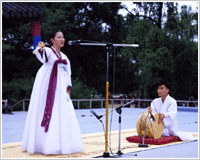|  | |
| Pansori first emerged during the mid-Joseon era (1392-1910), when common culture began to evolve. The scribes of Pansori and the year of their origin are hard to pinpoint- it began as an oral tradition that was continued by professional entertainers. During the Joseon era, entertainers were regarded as lowly peasants, which explains why Pansori remained mostly in commoners' circles. But towards the end of the Joseon era, aristocrats took notice- and the audience for Pansori operas increased. Originally a collection of 12 operas, there are now regrettably only 5 that have been passed down to us today- Chunhyangga, Simcheongga, Heungbuga, Jeokbyeokga, and Sugungga. A Pansori performance is lengthy, some even taking up to 4 to 5 hours to complete. In 2003, Pansori was officially recognized by UNESCO as an important piece of world culture. Source : visitkorea.or.kr | ||
13 September 2011
The Pansori Epic Chant
Subscribe to:
Post Comments (Atom)


No comments:
Post a Comment